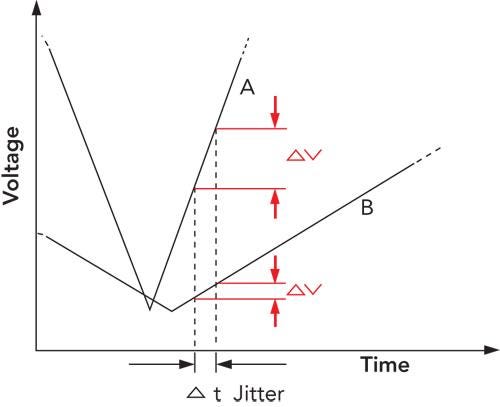What's the Noise in Signal-to-Noise Ratio?
January 11, 2012

A signal-to-noise ratio (SNR) lets us express the relationship between signal and noise powers, as well as between the root-mean-square (rms) values of signal and noise voltages:
SNR (dB) = 10log10(signal power/noise power).
SNR (dB) = 20log10(rms signal voltage/rms noise voltage).
In an analog-to-digital converter (ADC), noise -- or nonsignal power -- relates to the plus or minus 1/2 LSB quantization error introduced by digitizing a signal into discrete steps. The familiar equation below provides the SNR for an N-bit ADC based solely on quantization error for a pure sine wave over the Nyquist bandwidth; DC to fsample/2:
SNR (dB) = (6.02*N) + 1.76.
But this value tells only part of the story. ADC noise can arise from another source called effective input noise, created by the ADC's electronics. And jitter in the ADC clock signal also affects the ADC output. A poorly designed circuit board can let digital noise and other ambient signals couple to the clock signal and cause jitter.

You can find the complete root-sum-of-squares SNR equation that combines quantization noise, clock-jitter noise, and effective input noise in the document "Fundamentals of Samples Data Systems" by Walt Kester and James Bryant (page 2.72). The authors also show the theoretical basis for the third SNR equation.
You cannot overcome effective input noise except by choosing a different ADC that introduces less noise. Proper PCB layout, decoupling, and use of a stable low-noise clock signal can reduce jitter. The overall jitter time combines aperture jitter, which occurs in the ADC's sample-and-hold amplifier, with jitter in the ADC's sampling clock signal. The latter jitter usually predominates.
Clock jitter of a few picoseconds might seem to contribute little to an SNR value, but keep in mind that the effect of jitter increases with the frequency of an ADC input signal, as shown in the diagram.
The SNR value does not include power contributed by harmonics of the signal of interest, because you can -- and should -- eliminate harmonics with an anti-alias filter. If you include power from harmonics (but not DC), you get a signal-to-noise-and-distortion, or SINAD, ratio, also expressed in dB. Because a SINAD value includes all nonsignal energy, it can provide a good indication of actual ADC performance.
More information:
"ADC Input Noise: The Good, The Bad, and The Ugly. Is No Noise Good Noise?," Analog Devices.
"How Quantization and Thermal Noise Determine an ADC's Effective Noise Figure," Tutorial 1197, Maxim Integrated Products.
"Understanding the Effect of Clock Jitter on High Speed ADCs," Design Note 1013, Linear Technology.
Kester, Walt, ed., The Data Conversion Handbook, Newnes, 2005. ISBN: 978-0-7506-7841-4.
About the Author(s)
You May Also Like



